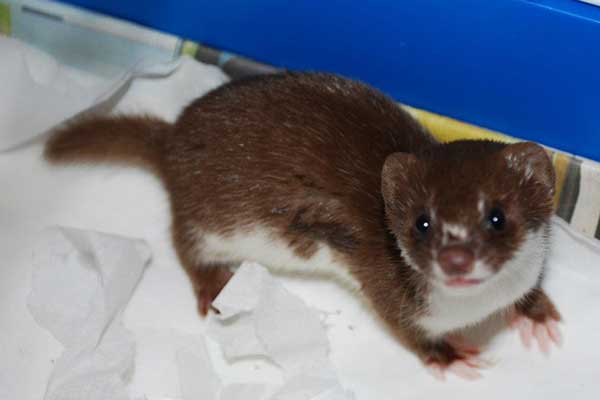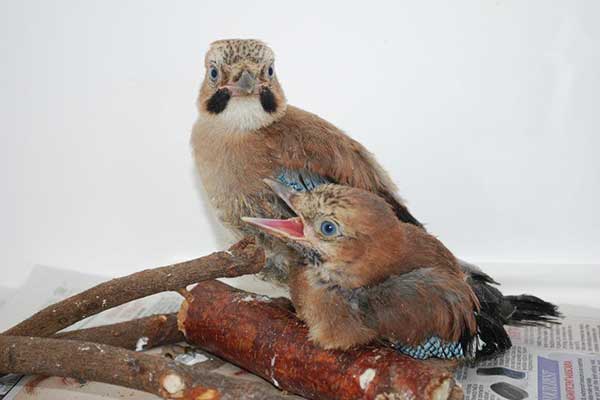We admit so many birds that it’s impossible to give general advice on them; species, size, shape, temperament and needs, vary so much. If you need to report a casualty or think a bird has been abandoned or orphaned, please contact us first (unless the animal is in immediate danger, when you may need to take prompt action) for advice. Phone the HELPLINE on 01892 543213.
Every year Folly Wildlife Rescue admits some 2500 birds. The following are a few of the most common incidents we deal with:
Baby Birds
Some authorities state that under no circumstance whatsoever should you pick up a baby bird and this is now so ingrained in people that many will stick to that line, even when it is pretty obvious that the circumstances demand they should intervene, i.e. they have just chopped down a shrub in their garden and baby birds have spilled out onto the ground.
Very often, we’re asked whether it would be better if ‘nature was allowed to take its course’. The answer is emphatically no, because generally, nature hasn’t had a hand in it at all.
Any nestling bird (a ‘nestling’ being a bird that has not yet fledged or left the nest) that is displaced from its nest, whether through destruction of the nest, cat attack or even blown out in high winds, should be picked up and brought into care. The parents are not able to return these babies to the nest and although they may well continue to feed them for a short while on the ground, they will eventually abandon them to their fate (i.e. certain death). Do not attempt to put any nestlings in another bird’s nest, in the nest they were originally in (that is now on the ground) and back up in another tree, or in any sort of basket or container that you think may replicate the original nest; it does not work and wastes precious time.
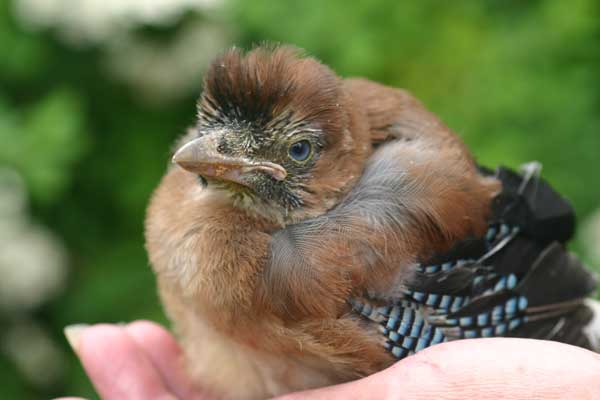
A young jay, hand-reared from a nestling. Every year we admit and rear large numbers of jays, jackdaws, rooks, crows and magpies.
Birds that have fledged (a fledgling is a bird that has left the nest), are a bit different. Many species (but not all) have, on fledging, only partial flight, and as it can take several days for the muscles to strengthen sufficiently, they spend this time hiding in dense shrubs and bushes with the parent birds bringing food to them. In addition, some fledglings, especially robins, blackbirds and song thrushes have little natural fear at this stage and will often approach people (and cats!) or even come into the house. Unless they are in immediate danger, they should be left alone, or gently ushered back into some nearby undergrowth.
Cat Attacks
Many fledglings advertise their whereabouts to their parents by cheeping periodically, but this of course helpfully pin-points their exact location to every cat in the area.
Unfortunately, with the proliferation of domestic cats in recent years (there are now estimated to be 10 million), huge numbers are killed or injured before they can fly properly and sometimes, one or both parents are killed trying to protect them.
If you suspect your cat is killing birds, keep it in for a few days. Any fledglings that have been injured or are in immediate danger should be picked up. If a cat brings a baby bird (or for that matter any animal) home in its mouth, do not under any circumstances put it back out again (the cat will soon catch it again), as it will certainly need treatment.
Cats will also target blue tit nest boxes and through their presence in the vicinity, will cause the parents to abandon the nest. Always ensure that bird boxes are well away from the ground and that cats can’t climb up to them. If a box has been abandoned, don’t try and move it to another location, as the adult birds will invariably ignore it. The young (and the nest box) should come into care for hand-rearing.
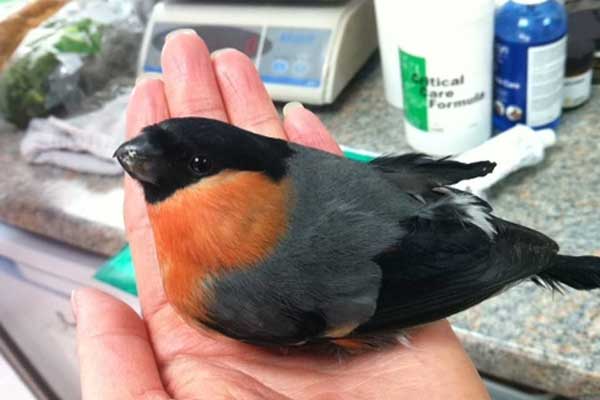
This beautiful male bullfinch came in to us as after a cat attack; he had swelling to his wing and was missing some tail feathers.
His colours are even more stunning in real life.
Sometimes one or both parents will be killed by cats as they leave the nest. A single parent will continue to try to feed the young, but because of the workload involved (or the continued threat of cats), will soon abandon them to their fate. Baby blue tits can be successfully hand-reared, but time is of the essence, so don’t delay getting advice.
All other birds attacked by cats need to come into care. Don’t be tempted to release them because they appear ‘all right’. Cat’s claw’s harbour dangerous bacteria and any injury left untreated will invariably lead to infection and death.
Chimneys
Birds of many species will fall down chimneys that don’t have a cowl fitted; jackdaws, woodpigeons, starlings and owls are the ones most at risk.
In some cases, it is possible to extricate them, but many more suffer a lingering death.
If there is access to the back of the fireplace and the hole is large enough, a bird can often be enticed out with a strong light left on the hearth, but it does need to be captured quickly if you are to avoid having the room redecorated with soot! Never release such a bird without first bringing it for a health check; soot clogs feathers and airways and many birds are left severely dehydrated too.
Ducklings
We admit hundreds of day-old mallard ducklings. Some have been orphaned after their mother’s have been killed by cars; others (mostly individuals) have hatched a little later than the main brood, and have been left behind, while many more come to us after the brood has hatched in an inappropriate location (for instance, a walled courtyard or close board fenced garden) from which they are then unable to make their way to water. A female mallard, when searching out a suitable nest site, can it seems, be easily confused, mistaking the water in a child’s paddling pool or a puddle on a flat roof, for a pond. She’ll duly lay her eggs nearby and proceed to brood them, only to find, when the ducklings hatch a month later, that they’re trapped.
If it is possible to catch the mother and the ducklings, they can all be re-released on a suitable pond or lake, but if (as sometimes happens) she flies off, the babies have to come in to care for rearing.
Grounded Baby Birds
As well as the occupants of nests that have been attacked by cats or destroyed by gardeners, the young of two other species, the woodpigeon and the collared dove, are often found on the ground. The adults birds frequently nest in conifer trees and these nests, which are really just a collection of sticks, criss-crossed between the branches are very vulnerable to high winds. In addition, because conifers are easy to climb, cats frequently target them, killing or injuring the nestlings (there are usually two per nest). So if you find one on the ground, it’s always a good idea to search around in case there is a second one. Although both species are distinctly ‘pigeon-like’ in appearance, they are sometimes mistaken for other birds. We get lots of calls about ‘baby herons’, ‘birds of prey’ and even ‘baby ducks’ but they invariably turn out to be young woodpigeons!
The young of both these species are very large before they fledge, but are still totally dependant on their parents for food. If you do find one (or two for that matter), don’t try to feed them, as it’s a specialist job and don’t attempt to give them (or any baby bird for that matter) water; if it enters the airways, the bird is doomed.

Tawny owl chick. Found on the ground.
Young feral pigeons are often found huddled in shop doorways, usually having fallen from a precarious nest situated on a ledge or window sill (and sometimes from under a bridge). If you come across one, try and get a cardboard box from a nearby shop to contain it in.
Shooting Incidents
Every year we admit ducks, pheasants, herons and cormorants which have been injured by shotgun pellets and left to die by ‘sportsmen’. These birds have usually suffered multiple injuries and few can be saved.
Another common cause of injury is the airgun pellet, often inflicted by a peculiar breed of person who delights in taking ‘pot shots’ from out of their bedroom window. Pigeons, woodpigeons, jackdaws and collared doves are frequent victims and suffer appalling injuries. This is completely illegal and anyone doing it should be reported to the Police. It is also extremely dangerous, as people have been badly injured or even killed by stray airgun pellets.
Local councils too often employ pest control companies to shoot pigeons (often in the evening when the birds are roosting) in the mistaken belief that they can ‘control’ them. This is not true; pigeon numbers can be controlled but the best method is to clamp down on the people who drop ‘fast food’ and the food outlets who fail to promote hygienic waste food management. Steps also need to be taken to ensure that ledges, walkways and window sills are properly protected and that empty shops and buildings are made inaccessible to pigeons with correctly installed and well maintained, pigeon deterrents.
Window Strikes
In a report a few years ago, the British Trust for Ornithology, estimated that 90 million birds a year in the UK fly into windows and that some 30 million of these are killed.
This is a very common problem and occurs when a bird, especially a young inexperienced one, seeing the outline of bushes and shrubs reflected in a window, tries to fly into them, often at high speed. We’ve all probably heard the ‘thud’ of a small bird hitting a window (and sometimes there’s dusty outline of it left on the glass) and generally the bird flies off uninjured, but in some cases the impact is so hard it is either killed outright or falls to the ground, stunned. If you find one, the best thing to do is put it in a box or cat basket (if you leave a bird on the ground it’s vulnerable to cats and other predators) and leave it quite, either in the house or in a shed for 20 minutes or so. Many make a full recovery and can be released, but if the bird cannot stand, has one or both feet ‘clawed’ or is propping itself up with its wings, the injury is likely to be more severe and it will require treatment.
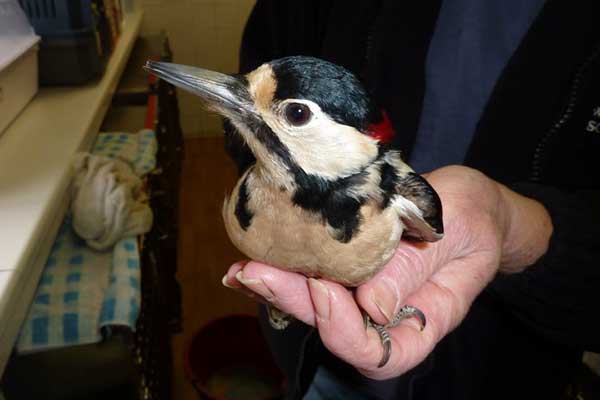
Greater-spotted woodpecker that was found concussed. It most likely hit a window (you can see that the tip of its beak is missing).
Sometimes, birds being chased by sparrow hawks will attempt this escape manoeuvre, resulting in both birds being killed or seriously injured. Other species prone to striking windows are woodpeckers, collared doves and even kingfishers.
If treatment, in the form of an anti-inflammatory injection, can be given within a few hours, many of these birds will go on to make a full recovery.
The above are just a very few examples of the many man-made incidents that are occurring all the time and which in some cases are having a profound effect on bird populations.
For advice or assistance, phone the HELPLINE 01892 543213.
Do's And Don'ts
If you find a casualty:
- Do put it in a secure container (cardboard box, cat basket etc) lining it first with either paper towels, toilet tissue or a soft cloth and bring it into the house.
- Do phone for advice and assistance as soon as possible.
- Donít put a water bowl in the container; if it spills, the bird will get wet and cold.
- Donít try and give the bird any water; it could go the wrong way and kill it.
- Donít try and give the bird any food; it may well be the wrong sort anyway.
- Do keep it in a quiet place until you can bring it to us (or if you havenít got a car, we can collect it).
- Donít be tempted to follow the advice of well-meaning friends who tell you to put it back where you found it or to Ďlet nature take its courseí.
You can make a secure online donation via our CAF page.
Click on the button below and a new page will open with a variety of options with which to pay online.
Your kind and generous donation will directly help injured wildlife.

It is easy to set up a regular standing order by clicking the CAF image below. You will be taken to The Southern Wildlife Care and Advisory Trust's page on the CAF website where it will take just a few easy steps to set up a standing order by direct debit.

easyfundraising.org.uk is a great way to raise money for Folly Wildlife Rescue just by shopping online. You donít pay anything extra.
All you need to do is use click on the banner below to use our easyfundraising portal. Every time make a purchase from your favourite online retailers using the link below Folly Wildlife Rescue will receive a small payment, with no extra cost to you.

With the endless stream of wildlife casualties brought in to Folly Wildlife Rescue we are continually looking for stocks of essential items to aid recovery. With the introduction of our new nursery we will be able to cater for even more little babies, and with that comes more expense and that is where you, our supporters, may be able to help.
Our Amazon Wish List is updated frequently with all the essential items we needr. Your support is absolutely invaluable to us and every item purchased is a vital saving for our charity.

An adoption pack makes a great gift for a birthday or Christmas (or you can always treat yourself!) and is a very practical way to help hedgehogs in distress.
As well as illnesses and injuries the species is now seriously threatened by loss of habitat and housing developments, increased road traffic and unsympathetic farming practices







